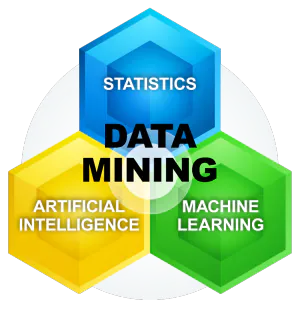Data Mining
What it is & why it matters
Data mining is the process of finding anomalies, patterns and correlations within large data sets to predict outcomes. Using a broad range of techniques, you can use this information to increase revenues, cut costs, improve customer relationships, reduce risks and more.
History
Today's World
Who Uses It
How It Works
Data Mining History & Current Advances
The process of digging through data to discover hidden connections and predict future trends has a long history. Sometimes referred to as “knowledge discovery in databases,” the term “data mining” wasn’t coined until the 1990s. But its foundation comprises three intertwined scientific disciplines: statistics (the numeric study of data relationships), artificial intelligence (human-like intelligence displayed by software and/or machines) and machine learning (algorithms that can learn from data to make predictions). What was old is new again, as data mining technology keeps evolving to keep pace with the limitless potential of big data and affordable computing power.
Over the last decade, advances in processing power and speed have enabled us to move beyond manual, tedious and time-consuming practices to quick, easy and automated data analysis. The more complex the data sets collected, the more potential there is to uncover relevant insights. Retailers, banks, manufacturers, telecommunications providers and insurers, among others, are using data mining to discover relationships among everything from price optimization, promotions and demographics to how the economy, risk, competition and social media are affecting their business models, revenues, operations and customer relationships.

Why is data mining important?
So why is data mining important? You’ve seen the staggering numbers – the volume of data produced is doubling every two years. Unstructured data alone makes up 90 percent of the digital universe. But more information does not necessarily mean more knowledge.
Data mining allows you to:
- Sift through all the chaotic and repetitive noise in your data.
- Understand what is relevant and then make good use of that information to assess likely outcomes.
- Accelerate the pace of making informed decisions.
Learn more about data mining techniques in Data Mining From A to Z, a paper that shows how organizations can use predictive analytics and data mining to reveal new insights from data.
Data Mining in Today’s World
Data mining is a cornerstone of analytics, helping you develop the models that can uncover connections within millions or billions of records. Learn how data mining is shaping the world we live in.
Demystifying data mining in oil & gas operations
Explore how data mining – as well as predictive modeling and real-time analytics – are used in oil and gas operations. This paper explores practical approaches, workflows and techniques used.
The intersection of big data & data mining
Data mining expert Jared Dean wrote the book on data mining. He explains how to maximize your analytics program using high-performance computing and advanced analytics.
